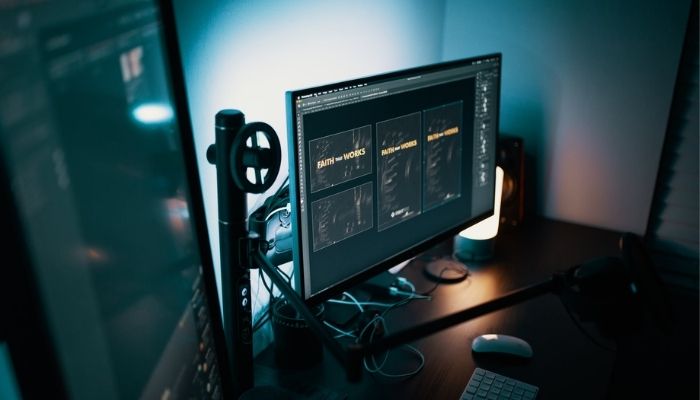If you’ve ever peeked at the backside of your computer (CPU), you’ll notice a multitude of ports. Each of these motherboard ports designS to fulfill a particular specified function.
A good example is the HDMI port. If you’re utilizing a graphic card, the HDMI port on the motherboard is blocked automatically. Enabling the HDMI port on the motherboard allows you to connect additional monitors through an HDMI cable.
Although your monitor may come equipped with a monitor and graphics card, if you have numerous displays or need to use an older monitor with greater resolutions, it may be necessary to purchase a graphics card.
We will explore the benefits of using the motherboard HDMI port in this article and How to Connect Monitor to Motherboard HDMI? There are numerous occasions in which activating the HDMI port on the motherboard is advantageous.
If you want to use the HDMI port on your motherboard, you must follow one of the following methods. Please avoid using any available shortcuts, as they may cause your motherboard to overheat and trigger a more significant problem.
These steps enable HDMI on the motherboard. It makes no difference if you choose to manage the HDMI port on your motherboard for your primary or secondary monitor. The method is similar.
How to Connect Monitor to Motherboard HDMI?
The following procedures will detail each step required to enable onboard display connectors on your motherboard.

How to Configure the Display Adapter?
- Locate Display Adapters in Windows’ Device Manager.
- Identify the graphics that are incorporated. Two display adapters should list in the menu below.
- Most of them will be integrated graphics such as Intel or AMD.
Confirm That Your Processor Includes Integrated Graphics
- Launch the Windows 10 Settings application by typing “Settings” into the taskbar’s Search menu.
- Alternatively, you can start the Settings App by pressing the Windows, and I keys on your keyboard.
- Click “System” in the Settings App to access the system settings.
- Click “About” at the bottom of the left-side panel.
- Under “Device specs,” below the title “Processor,” locate the CPU model for your system.
It would be beneficial if you chose the second option.
- The Intel website includes a user-friendly CPU database that summarises all relevant specifications.
- While, as long as you know the correct model number for an AMD processor, poring over the AMD website will reveal all of its specifications.
- To determine whether your CPU can process display outputs via the onboard connectors, examine the manufacturer’s website to see if it includes integrated graphics.
- These processes will demonstrate how to install the particular model of a CPU in a Windows 10 system:
- After obtaining the proper CPU model, navigate the manufacturer’s website and review the integrated graphics specifications.
Ensure that Integrated Graphics Enable in your BIOS
Once you’ve verified that your CPU includes integrated graphics, you’ll need to enable them in your BIOS (Basic Input Output System). There is a need to restart your system to properly Connect Monitor to Motherboard HDMI.
Additionally, a prompt may appear on the boot screen instructing you on which button to hit. When the BLUE screen appears, access the BIOS by pressing the standard keys (F2, DEL, ESC, F8, and F12).
The BIOS screen access by pressing these standard keys. Take note that each BIOS interface is unique, depending on the brand or model of the motherboard.
Once at the BIOs menu, take extra care when clicking buttons. One incorrect button push will throw your operating system into disarray. Keeping this in mind, navigate to the advanced settings.
- Navigate to graphics configuration by searching for and selecting “System Agent Configuration.”
- Following that, check for the “Enable GPU” or “Integrated Graphics” or “IGPU Multi-Monitor” option.
- Activate the setting. You may need to re-confirm by pressing Enter. Restart the machine to confirm that the changes are correctly applied.
- These settings are set to “Disabled/Off” by default. If any of the following options appear on your BIOS screen, choose “Enable/On” to activate the Integrated Graphics. Exit and save your settings.
Connect your Monitors
The next critical step is to connect the monitors to the CPU. Connect the monitors to the CPU at all times while the computer switches off. If you connect displays to the CPU where the computer is running, your system will not detect any monitors.
- Attach your Primary Monitor to the HDMI port on the backside of the graphics card after powering down your system.
- Connect your Secondary Monitor to the motherboard’s HDMI port.
- After connecting both monitors to your computer, click the other end of the HDMI cable to your primary and secondary monitors.
- After connecting everything, power on your PC and log in to Windows.
- To customize the display, right-click on the desktop and select Display settings.
- Now, double-check that your primary and secondary displays are in the correct order. If not, you can manually align them by dragging them. Apply.
Update Integrated Graphics Drivers
It’s simple to update the integrated graphics cards. You do not need to retrieve any software via the Internet. This step is necessary if your second monitor does not identify due to a graphic card malfunction.
If your system is Intel-based, we recommend that you install the most recent Intel HD Graphics drivers via the Intel Driver and Support Assistant app.
The following actions are required to update the graphics card:
- To begin, click the start symbol.
- Click the “device manager” in the computer window or locate it in the control panel.
- Navigate to the “Display Adapter” section.
- Determine the inbuilt GPU.
- If it is not listed here, it can locate under the “Other Devices” section as an Unidentified Device.
- Alternatively, you can download the latest driver from the download website for your CPU manufacturer and let Windows search for the correct driver automatically.
- Then restart your monitor and wait till the secondary monitor is detected.
- This application automatically recognizes all Intel components on your system, searches for and installs the most recent available drivers.
- Similarly, AMD provides the Radeon Software Adrenalin 2020 download and installation application for systems equipped with Radeon Graphics and Ryzen Chipsets.
- Restart your monitor and rejoin the display monitor after updating all drivers.
Restart the computer monitor
- Restart the display and wait for it to be recognized. If your screen pops up, you have updated the drivers successfully.
- Once you’ve learned how to activate motherboard HDMI, it’ll be simple to do so on future builds or when replacing an old motherboard with a new one.
- Keep in mind to double-check the BIOS settings and ensure they are activated.
- It enables you to use several screens successfully, whether playing games or conducting multiple jobs.
The Advantages of Using the Motherboard’s HDMI Port
One of the most critical benefits of enabling the motherboard’s HDMI port is that it allows for the simultaneous connection of several displays. It can be a fantastic experience for anyone who enjoys an immersive game or film experience.
Additionally, having many monitors connected enables you to maintain a consistent workflow and perform multitasking more efficiently.
Additionally, the HDMI port’s key advantage is that it can transmit 8K video, Dolby Digital audio, and internet connectivity to your monitor through a single cable.
If your GPU’s HDMI port is damaged, the motherboard slot may come in handy if you wish to display several displays. If you enjoy high-performance gaming, the additional RAM provided by the second monitor can offer a significant advantage when playing titles like Cyberpunk 2077 and others.
Frequently Asked Question
What Is Motherboard and Its Function?
The motherboard acts as a common foundation for connecting all of the components of a computer. It directly or indirectly connects the CPU, RAM, hard drives, optical drives, video cards, sound cards, and other connections and expansion cards. It can consider of as the computer’s backbone.
What Does an HDMI Cable Do?
HDMI stands for High-Definition Multimedia Interface, a protocol for sending digital video and audio concurrently from a source, such as a computer or a cable box, to a computer display, television, or projector.
Is HDMI and USB Cable the Same?
While USB technology enables similar devices such as computers and computer hardware, HDMI enables the connection of high-definition devices, including TV screens, Blu-ray and DVD players, video game consoles, and computers.
Conclusion
Do we hope our post effectively guided you through the process of connecting Monitor to Motherboard HDMI? Enabling the HDMI port on the motherboard allows you to connect additional monitors through an HDMI cable.
To summaries, enabling built-in HDMI on your motherboard requires that your processor has integrated graphics. As soon as you discover that your processor lacks integrated graphics, do not bother enabling the onboard ports in BIOS.
If you want to use both independent GPU ports and integrated graphics simultaneously, you must upgrade your CPU to one with integrated graphics. On the other hand, if Step 1 of these methods is satisfied, proceed to BIOS, allow the connectors, and update all drivers.
